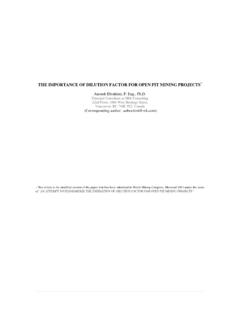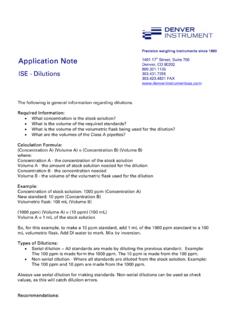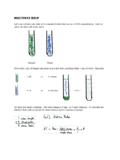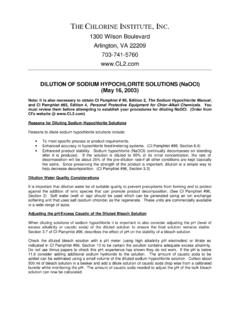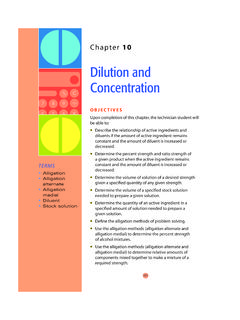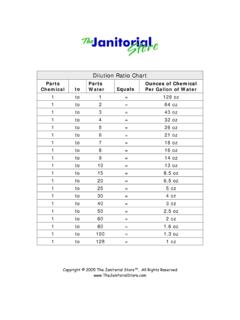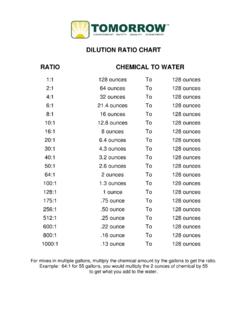Transcription of Determining the Cause of Fuel Dilution of Engine Oil{1251 ...
1 Special Instruction Determining the Cause of fuel Dilution of Engine Oil{1251 , 1290} Determining the Cause of fuel Dilution of Engine Oil{1251 , 1290} SMCS - 1251; 1290 Articulated Truck: 735 (S/N: B1N1-UP) 740 (S/N: B1P1-UP) 740 EJECTOR (S/N: B1R1-UP) Cold Planer: PM-200 (S/N: P1C1-UP) PM-201 (S/N: PNM1-UP) Landfill Compactor: 826H (S/N: AWF1-UP) 836H (S/N: BXD1-UP) 836H CUSTOM (S/N: XTR1-UP) Soil Compactor: 825H (S/N: AZW1-UP) Excavator: 365C L (S/N: ELC1-UP) 365C L MH (S/N: GWC1-UP) 365C L (S/N: MEM1-UP; PAR1-UP; MCS1-UP; MCY1-UP) 385C L (S/N: EDA1-UP) 385C FS (S/N: MMA1-UP) 385C L (S/N: KGB1-UP) 385C (S/N: KBC1-UP) 385C L (S/N: SBE1-UP) 385C (S/N: T2E1-UP) 385C FS (S/N: T2F1-UP) 385C (S/N: KKK1-UP) 385C FS (S/N: EAM1-UP) 385C (S/N: JCM1-UP) 385C FS (S/N: GLT1-UP) 385C L MH (S/N: WAW1-UP) 385C (S/N: MNZ1-UP) 365C (S/N: FEN1-UP) Load Haul Dump: R2900G (S/N: JLK1-UP) Off-Highway Truck/Tractor: Shutdown SIS Previous ScreenProduct: NO EQUIPMENT SELECTED Model: NO EQUIPMENT SELECTED Configuration.
2 NO EQUIPMENT SELECTED Media Number -REHS3007-00 Publication Date -2006/09/11 Date Updated -2006/09/11 i02616891 Page 1 of 6 Advanced Full Text Search - REHS3007 - Determining the Cause of fuel Dilution of ..05/02/2007 (S/N: EED1-UP) 777F (S/N: JRP1-UP) Quarry Truck: 775F (S/N: DLS1-UP) Pipelayer: 583T (S/N: CMX1-UP) Track-Type Tractor: D10T (S/N: RJG1-UP) D7R Series II FTC XR (S/N: BPK1-UP) D8T (S/N: J8B1-UP; KPZ1-UP) D9T (S/N: RJS1-UP) Underground Articulated Truck: AD30 (S/N: DXR1-UP) AD45B (S/N: CXM1-UP) AD55 (S/N: DNW1-UP) Wheel Dozer: 824H (S/N: ASX1-UP) 834H CUSTOM (S/N: XDC1-UP) 834H (S/N: BTX1-UP) 844H (S/N: BTW1-UP) Wheel Loader: 980H (S/N: MHG1-UP; A8J1-UP) 980H CUSTOM (S/N: JMS1-UP) 988H CUSTOM (S/N: BXY1-UP) 990H (S/N: BWX1-UP) Wheel Tractor-Scraper: 621G (S/N: DBB1-UP.)
3 DBX1-UP) 623G (S/N: DBC1-UP) 627G (S/N: DBD1-UP) 631G (S/N: DFA1-UP) 637G (S/N: DFJ1-UP) 657G (S/N: W1B1-UP; W1C1-UP; W1E1-UP; W1F1-UP) Introduction Before you perform any procedure in this Special Instruction, read the information and understand the information that is contained in this instruction. This special instruction includes the recommended methods for Determining fuel Dilution of the Engine oil. Additionally, the probable causes and recommendation for correcting the fuel Dilution are provided. Recommended Actions Measuring fuel Dilution Diesel fuel is chemically similar to the lubricants that are used in diesel engines. A slow fuel leak will blend the fuel into the oil.
4 Normal operating temperatures may Cause volatile parts of the fuel to vaporize. The fuel that remains in the oil is less volatile. A closed cup flash test is sometimes used to detect fuel Dilution . The flash test is designed to measure the volatile parts of the fuel that are remaining in the oil. Detecting less volatile fuel is difficult. This reduces the accuracy of the flash test. Page 2 of 6 Advanced Full Text Search - REHS3007 - Determining the Cause of fuel Dilution of ..05/02/2007 the flash test does not accurately detect fuel Dilution , do not use the flash test as the only measure of fuel Dilution . Instead, verify the Dilution by the following methods: Gas chromatograph fuel Dilution test Oil viscosity The gas chromatograph method is designed to measure fuel Dilution in crankcase oils.
5 The gas chromatograph instrument can identify the small chemical differences between diesel fuel and lubricating oil. A gas chromatograph is used to measure fuel Dilution at all Caterpillar regional SOS Service labs. Some Caterpillar dealers also use a gas chromatograph. Even though the gas chromatograph provides a more accurate measure of fuel Dilution , always verify the results with the viscosity test. A significant level of fuel Dilution reduces oil viscosity. If an unacceptable level of fuel Dilution is suspected, the kinematic viscosity of the oil must be measured. fuel Dilution that is greater than four percent will usually Cause viscosity that is less than the specified viscosity grade.
6 If the oil is still within the specified viscosity grade, it is likely that fuel Dilution has not reached an unacceptable level. Use the following chart to determine if viscosity has reached the minimum acceptable level. The guidelines of viscosity in the chart are slightly less than the limits of the SAE viscosity grades. However, these guidelines still provide adequate Engine protection. Verifying fuel Dilution Always verify fuel Dilution by the combination of low oil viscosity and a gas chromatograph result in excess of four percent before investigating or servicing the Engine . Ask your dealership to submit an oil sample to a Caterpillar regional SOS Service lab for analysis if a gas chromatorgraph fuel Dilution test cannot be performed at your dealership.
7 Troubleshooting for Sources of fuel Dilution Use the following procedure to determine the locations of sources of fuel Dilution around the electronic unit injectors under the valve cover. The tools that are required are listed below: Table 1 Viscosity Grade Minimum Oil Viscosity at 100 C with fuel Dilution Greater Than 4% as Measured by a Gas Chromatograph Action 0W-40 5W-40 10W-40 15W-40 cSt Investigate the Cause of fuel Dilution or reduce the Engine oil change interval. Refer to the Engine 's Troubleshooting manual. 0W-30 5W-30 10W-30 cSt Page 3 of 6 Advanced Full Text Search - REHS3007 - Determining the Cause of fuel Dilution of ..05/02/2007 1U-5566 Ultraviolet Lamp Gp 1U-5575 Additive Dye 19 L (5 US gal) container for fuel Note: The Engine must be at operating temperature or near operating temperature in order to perform this test.
8 Note: Do not exceed 745 kPa (108 psi) of fuel pressure in the rail of the cylinder head when you pressurize the fuel system with a priming pump. 1. Add dye to the fuel in the container per the instructions for the dye and mix well. 2. Put the inlet and return lines for the fuel in the container with dyed fuel . the Engine . Operate the Engine until at least 11 L (3 US gal) of fuel is used, or operate the Engine until the dyed fuel has returned into the container. Stop the Engine . 4. Remove the valve covers. 5. Cap the fuel line and pressurize the fuel system with a priming pump. the black light to inspect all of the unit injectors. A leak is indicated by a definite streak of dyed fuel at the leaking location.
9 Refer to the illustration below for the areas on the unit injector where leakage is considered normal, and for the areas where service is required. Leaking Seals on the Body or the Sleeve of the Unit Injector Page 4 of 6 Advanced Full Text Search - REHS3007 - Determining the Cause of fuel Dilution of ..05/02/2007 the torque for the unit injector clamp retaining bolts. Ensure that the unit injectors are properly installed into the cylinder head. Look for damage to the unit injector sleeves and for damage to the O-ring seals. Replace any seals or sleeves that show evidence of leakage. Leaking from the Seal from the Solenoid to the Housing or Cracked Body of the Unit Injector Use the ""Troubleshooting for Sources of fuel Dilution " " procedure above to confirm the location of the fuel leak either from a solenoid to the joint for the seal for the housing or from a damaged unit injector body.
10 Remove injectors that are suspected of having a damaged body and inspect the injectors for visible cracks. Replace a unit injector if either the solenoid to housing seal is leaking fuel or if the body is found to be cracked or damaged resulting in a fuel leak. Excessive Leakage from the Unit Injector Tip or a Broken Unit Injector Tip Look for signs of damage to the unit injectors. If necessary, replace the unit injectors that have damaged tips. Use 164-3310 Infrared Thermometer , 164-3320 Infrared Thermometer Gp , or 166- Illustration 1g01303494(1) fuel leakage is normal in these areas. Do not replace the fuel injector if fuel is leaking in this area. (2) Replace the fuel injector if fuel is leaking in this area.
